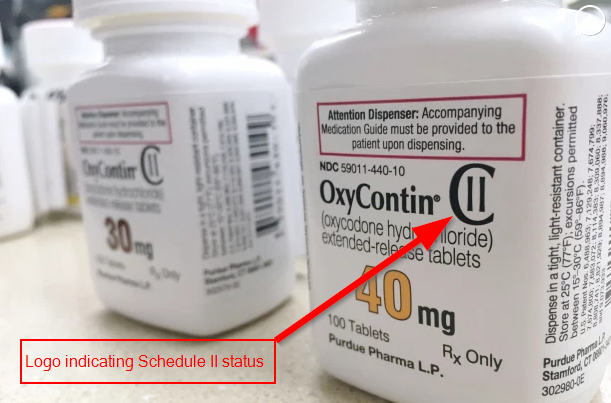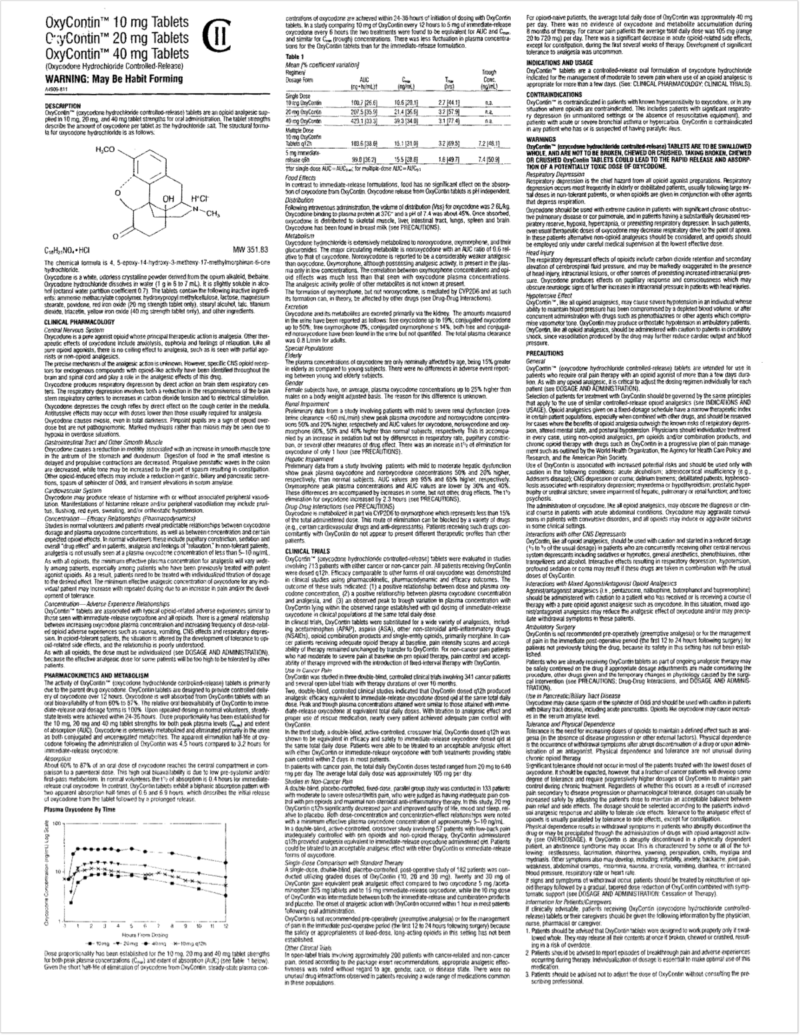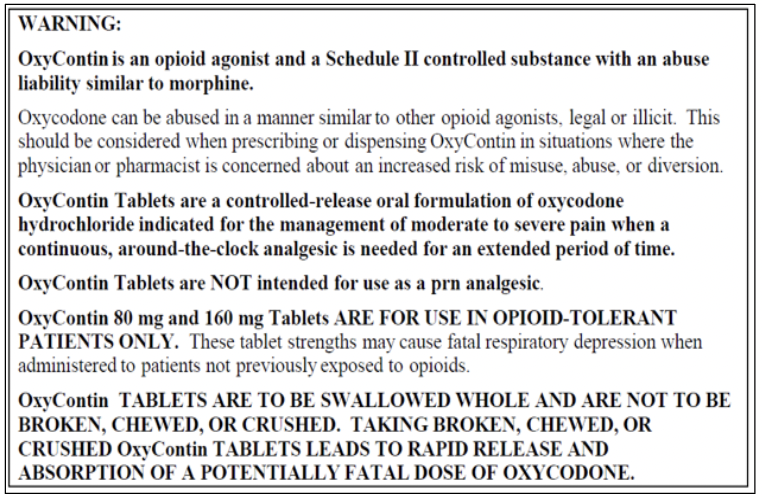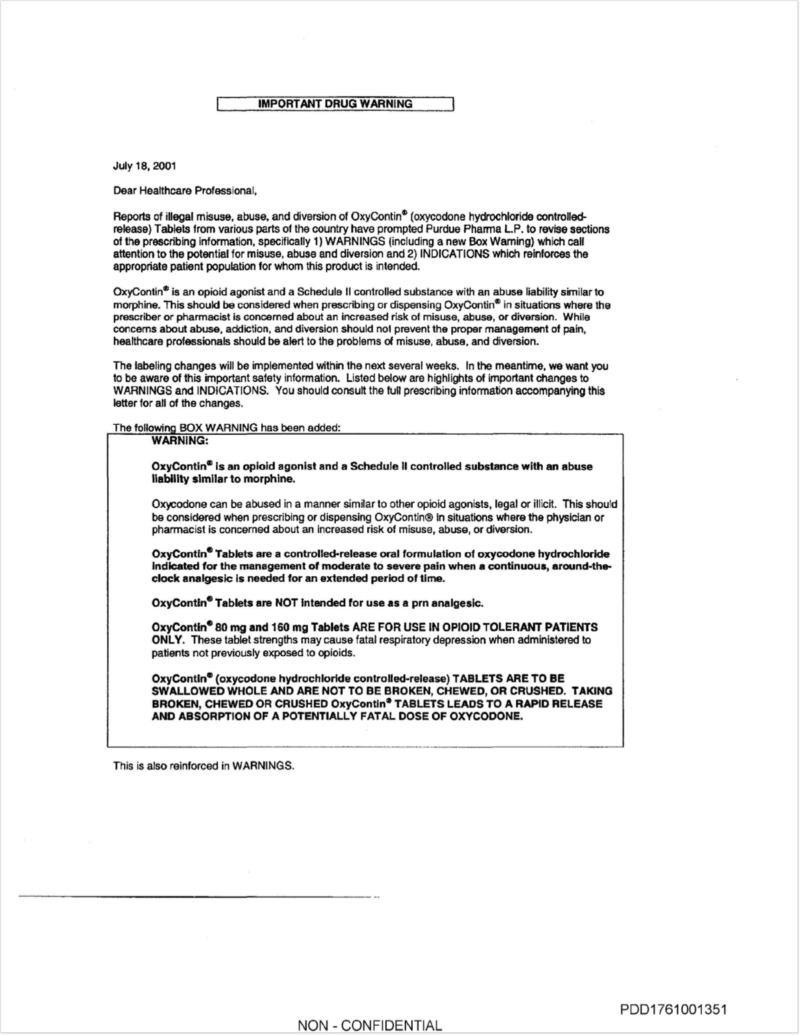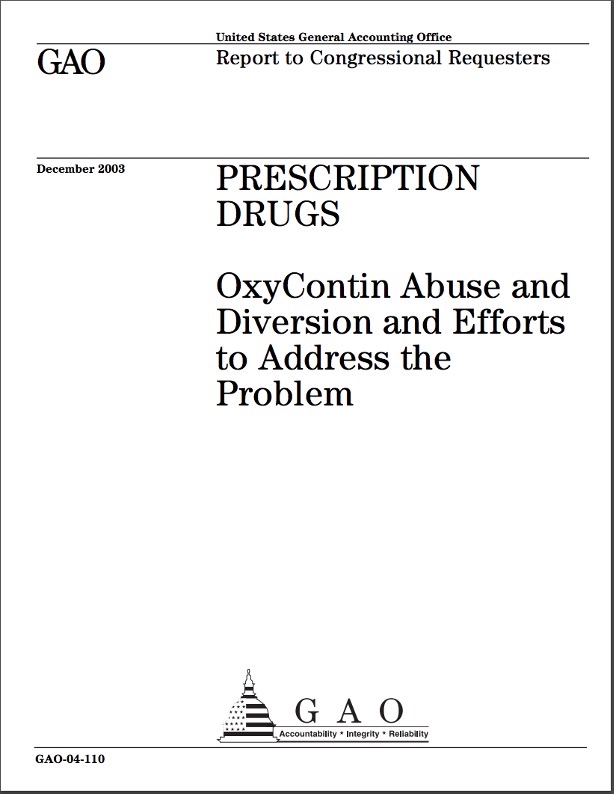OxyContin Addiction Risk
All opioids have been known to be addictive since the Sumerians referred to poppies as the “joy plant” in 3400 BC. Morphine was invented in the early 1800s and was also known to be addictive.
Prescription opioids, including OxyContin, are recognized by medical authorities and approved by the FDA for millions of Americans who suffer from chronic pain. Only a small percentage of patients who take opioids as prescribed develop dependence, and an even smaller percentage become addicted.
OxyContin’s Label Has Always Disclosed Risk of Addiction
All opioids have been known to have the risk of addiction for thousands of years, and the FDA-approved OxyContin label has always disclosed this risk. In addition:
- Risks of abuse and death have consistently been disclosed.
- OxyContin’s label has repeatedly been updated to reflect advances in scientific knowledge.
- A Black Box Warning has been prominently displayed on the label since 2001.
- Purdue communicated warnings and label revisions clearly to healthcare providers.
Risk of Abuse, Addiction & Death Always Prominently Disclosed on OxyContin’s Original 1995 Label
“Taking broken, chewed or crushed OxyContin Tablets could lead to the rapid release and absorption of a potentially toxic dose of oxycodone.”
“Oxycodone products are common targets for both drug abusers and drug addicts.”
“OxyContin is a mu-agonist opioid with an abuse liability similar to morphine.”
“Delayed absorption, as provided by OxyContin tablets, is believed to reduce the abuse liability of a drug.”
1995 OxyContin label[1]
“WARNING: May be Habit Forming”
“OxyContin is a mu-agonist with an abuse liability similar to morphine, and is a Schedule II controlled substance.”
“Oxycodone products are common targets for both drug abusers and addicts.”
“Patients should be advised that OxyContin is a potential drug of abuse. They should protect it from theft, and it should never be given to anyone other than the individual for whom it was prescribed.”
“Physicians should be aware that psychological dependence may not be accompanied by concurrent tolerance and symptoms of physical dependence in all addicts. In addition, abuse of opioids can occur in the absence of true psychological dependence and is characterized by misuse for non-medical purposes.”
“OxyContin … TABLETS ARE TO BE SWALLOWED WHOLE, AND ARE NOT TO BE BROKEN, CHEWED OR CRUSHED. TAKING BROKEN, CHEWED OR CRUSHED OxyContin TABLETS COULD LEAD TO … A POTENTIALLY TOXIC DOSE OF OXYCODONE.”
“… care should be taken to prevent diversion or abuse by proper handling.”
1995 OxyContin label[1]
2001: Language Strengthened Further & Black Box Warning Added to Label
Removed statements (from original 1995 label):
- “Delayed absorption, as provided by OxyContin tablets, is believed to reduce the abuse liability of a drug”
- “Iatrogenic ‘addiction’ to opioids legitimately used in the management of pain is very rare.”
OxyContin label revised to include Black Box Warning, the highest level of warning to physicians, and also language surrounding “misuse, abuse and diversion of opioids”:
- “Oxycodone is an opioid agonist of the morphine-type. Such drugs are sought by drug abusers and people with addiction disorders and are subject to criminal diversion.”
- “Oxycodone can be abused in a manner similar to other opioid agonists, legal or illicit. This should be considered when prescribing or dispensing OxyContin in situations where the physician or pharmacist is concerned about an increased risk of misuse, abuse, or diversion.”
- “OxyContin has been reported as being abused by crushing, chewing, snorting, or injecting the dissolved product. These practices will result in the uncontrolled delivery of the opioid and pose a significant risk to the abuser that could result in overdose and death (see WARNINGS and DRUG ABUSE AND ADDICTION).”
2001 Purdue Sent Letter to Prescribers Alerting Them to Label Changes
In 2001, Purdue sent “Dear Doctor” letters to 800,000 physicians[2] nationwide informing them about the new label.
“FDA worked with Purdue to develop “Dear Health Care Professional” letters, which the company distributed widely to health care professionals to alert them that the package insert had been revised to clarify the indication and strengthen the warnings related to misuse, abuse, and diversion.”
December 2003[3]
